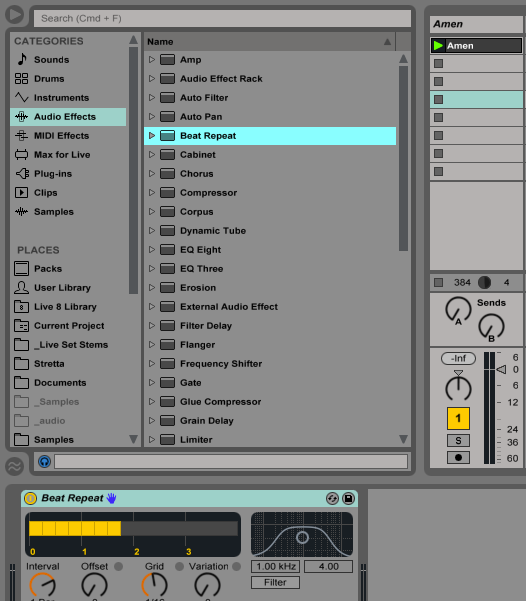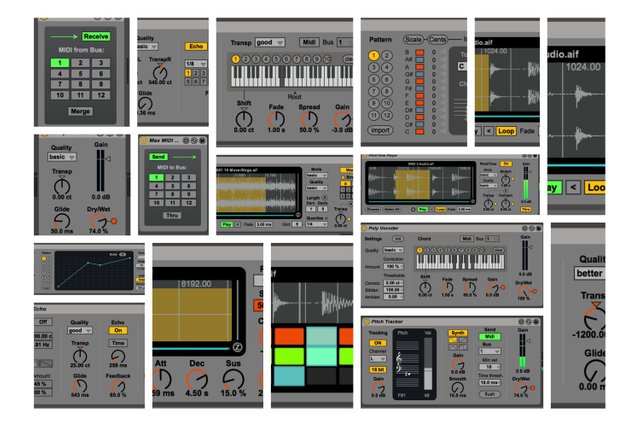New Blogisode- DAW VST’s

Welcome again my Steemit friends.
This is the 3rd instalment of the New VST Blogisode where we are looking at the variety of VST’s on the market from the top end symphony instruments and sound design tools to the freely available sounds and tools. We are going to look at the VST’s provided with your DAW software, mainly the three main DAWs, Ableton, Protools and Cubase and today its Ableton. As per the usual custom, if you like these Blogisodes, please share them and UPVOTE, UPVOTE, UPVOTE or try the promote button and see what that does.
Ok so when you first start with a DAW and get the basics set up the first thing we all really want to do is PLAY! “What can this stuff do and how can I do it as fast as possible?”. These are usually the first thoughts that come into your head right?. Now if you are like me, you want to play with some sounds and make some noises with the synths that you read about and how cool they were when you were deciding to buy the product in the first place right? That’s right.
I must admit this and be openly honest. When I was studying my degree, we had to use Ableton 9 and not having a few hundred $ to buy the product, I got a cracked version to play with and I didn’t have to travel 1 1/2hrs to college every day to use the college computers. (there that’s my confession). I had no real idea what it was and having to get used to the interface, which was a very different design from Protools with the live setup window. However, as time went on and after a few classes I started to see how things worked. In my final semester I did a lot of sound manipulation projects and real sound design with a variety of the various genres of music and sound design from post modernism, Music concrete, Chiptunes and more.
Some Ableton instrument lists:

We would have the opportunity to use Ableton and really play with the most basic samples and create other sounds and productions. For instance, we had to get a very short sound about one bar long and turn it into a drone piece that lasted about 6-9 minutes. So how in the hell was I supposed to do this? Well by getting that short sample, and doubling it on a second track in Ableton live. I then added some reverb to the first track with a long tale and recorded it to the second track. I took the second track and added another delay along with some other tools such as delay doubler and before long and a few more track recordings I had my production, a long haunting delayed drone.
I found that Ableton with its collection of basic tools and sounds (I could get more sound samples from the college libraries) I could do some cool things. I really learned how to do some chopping and dicing of samples and remix with this DAW and started to realise the power of it. I don’t use it that often now, except to do a few dance tracks when I’m in the mood, but let’s look at what the basic package provides.
I find Ableton is great for the electronic genre. It has tools that are so much easier to manipulate and work with than any other daw. I love making some great bass drops, the ability to just take one sample, chop it up and manipulate it with bit crushing, or use envelope manipulation to drag out the tails of the sample, or make slow rises or a fast attack can be simple and the tools of Ableton are simple in layout, but are still technical and agile in their application. As I mentioned in the pt. 2 blogisode relating to Waves plugins, the graphical user interface (GUI) for Ableton tools has been kept very plain and simple given the likelihood of the program needing to rely on many VST’s. Its clear the designers intentionally kept things simple to save space for RAMM and processing power for music creator.
Ableton has recently added new features and textures to the program to improve workflow and general design and you can see a few here:
https://www.ableton.com/en/live/whats-new/#max
Looking at features, Ableton has plenty and they are arranged very simply and in a neat order that’s easy to access. In the earlier photo near the top, you can see that there are MIDI effects, Audio effects, Instruments (you can find extra plugins around the web, most of them free I’ve heard and Live map set ups can also be found for free or purchased from artists like Tom Cosm on YouTube!! A very good Ableton beat designer from New Zealand), you also have instruments in the list and other tools including compressors and bus tools like limiters and so on. (as a hint never put much on your master channel except a final limiter to control the overall dB output).
The photo below is a collection of images of the basic Ableton tools that generally come with the program, I assume that a purchased copy will include a decent amount of VST’s and samples as well as other plugins.

But perhaps most awesome thing that you can do with Ableton is to CREATE YOUR OWN VSTS!! Yep, you can build and design your own tools and sound shapers to create and manipulate your projects. This can take a little time and there are plenty of YouTube videos around to learn how to do this, but the true benefits of making your own tools is that you are starting your way to creating your truly original sound. A Sound that no-one else can imitate, and that’s one of the cornerstones of sound design, originality, creativity through independence and the personal quest to make new music and sound for others to experience.
To summarize, I find that Ableton is a master’s tool for very creative music design that allows you to start as a beginner and then really grow with your designs and music. Ableton has simple tools with simple interfaces that sound great, there are large amounts of free applications and tools to help you on your path as a producer. But even with all these tools you need the know how to make them work, and that requires technique and knowledge and takes time to learn.
I have found for me that Ableton is a great place to develop music of many genres easily and relatively fast. Once you understand how the interface works and how to navigate around it quickly, it gets easier. So here is some of the features:
Warping and Time stretching your samples
Heaps of common tools and vsts from compression, limiting, amp simulation for distortion, reverbs, delays and so on.
Drum samples
Drum machines
Adding new free plugins and instruments
Its compatible with almost anything out there
Comes with some decent samples provided to play with
Make your own samples and manipulate them to infinity
Great midi functions and controls
Very easy to edit your work and move things around to restructure your music
A good and colourful interface when you need to find things (provided you organise your tracks properly.
Easy to write in your edits over your work flow such as adding fades and envelopes etc.
Doesn’t use a lot of your PC power to function well
Plenty of easy instructions to find with a good help window at the ready.
So, as you can see, there is so much to discuss and only limited space for me to write so I have tried to discuss the more salient aspects of the DAW and its VST’s and it’s difficult to go all the way through everything, but be assured that if you are looking for a DAW that is packed full of features for music production, Ableton is the 'GO TO' especially for producers of Electronic music. By the way, Ableton also makes its own hardware called the 'Push' and the 'PUSH 2', which are just f**kin amazing systems to use for programming and live play/ record but we may discuss them another time.
It’s not the program I would suggest to record live music, but it’s no real problem if it’s all you have. All in all, I give Ableton live 9 a 9.5 out of ten for versatility and total madness of design and playability! You can find more about Ableton here:
https://www.ableton.com/en/
Please UPVOTE UPVOTE UPVOTE, thank you so much. These are up-voted the more people we can reach!
Regards
Shan the Sound man
I use Ableton mostly for sound design for game projects. The ability to drag an audio file and manipulate its pitch, rotate it, speed it up or slow it down, add transposition modulation and stuff, is super handy and is designed much better than in most other DAWs. It's worth it just for that alone.

Here's what I'm referring to:
It's right there when you select a sample and it's the most convenient implementation out there.
Downvoting a post can decrease pending rewards and make it less visible. Common reasons:
Submit
yep thats the type of set up that really works well. You can set up whole rack of varioys chained effects to create a great flow and thats just for one track if needed. So much versatility in Abelton! thanks for your feedback and i am sure this kinda sharing dialogue will help others go further with their music design, Thanks for your reply matey!
regards
Shan
Downvoting a post can decrease pending rewards and make it less visible. Common reasons:
Submit